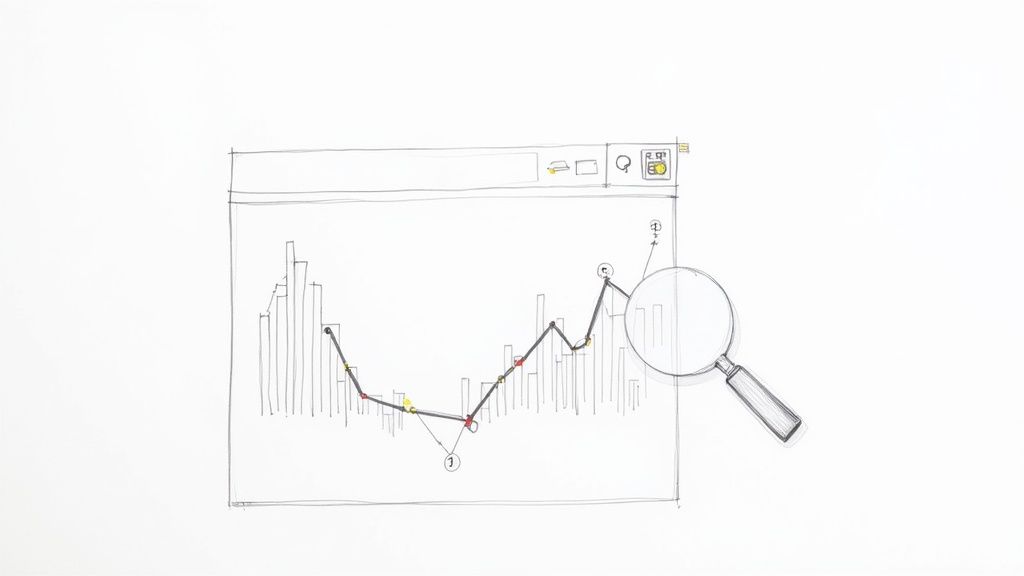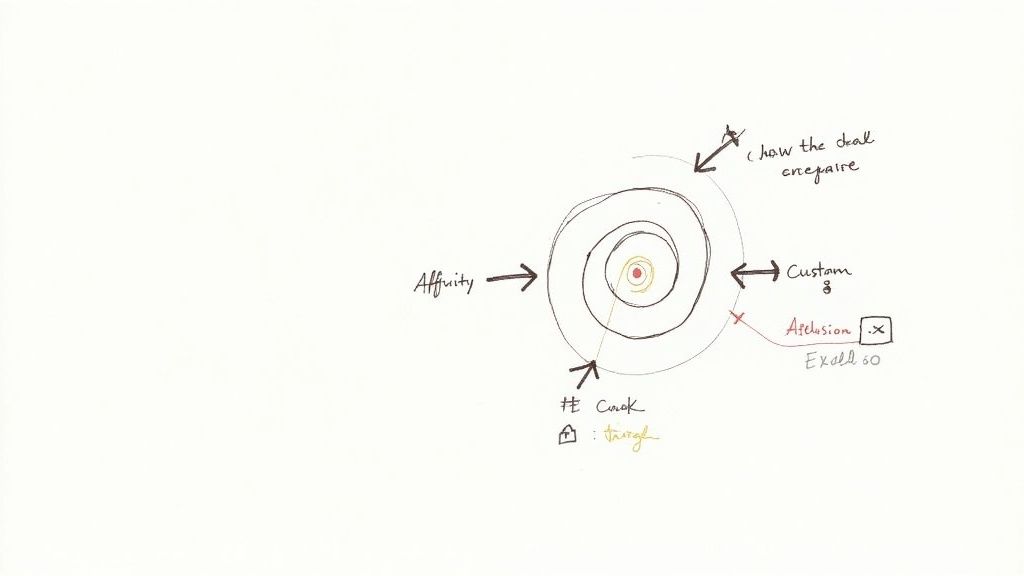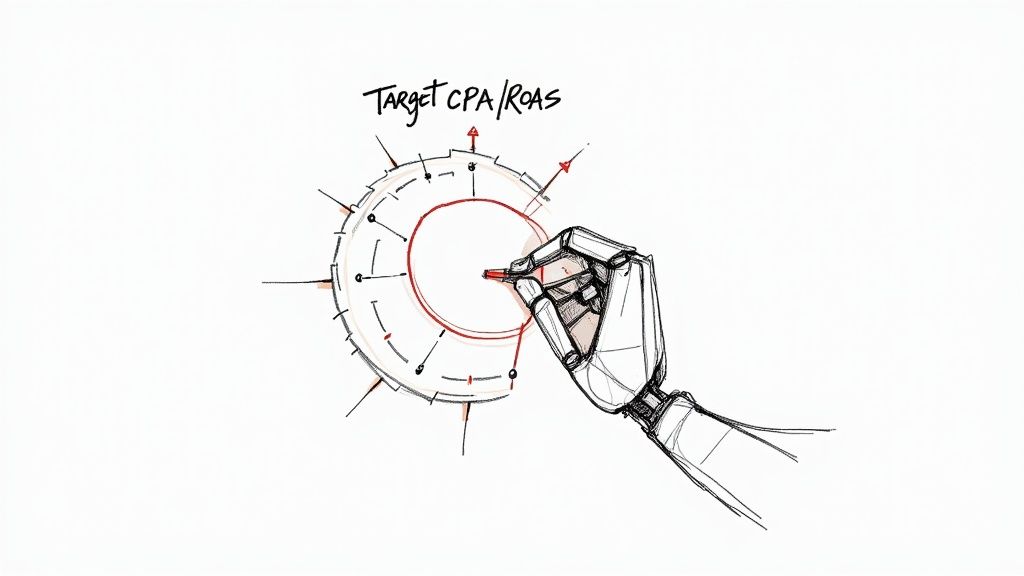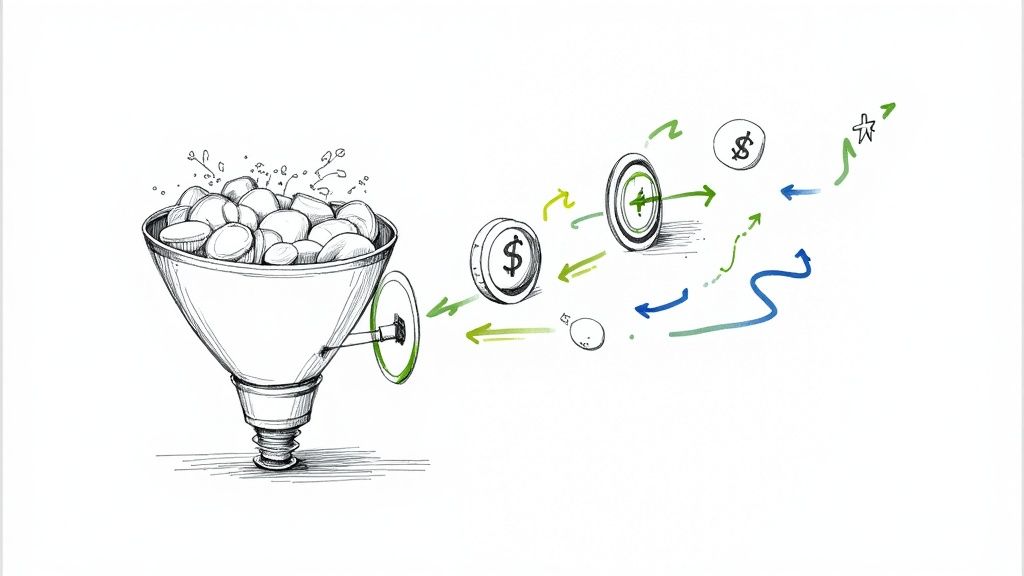If you're trying to lower your customer acquisition costs in Google Ads, you need to think like a detective. It's all about finding the campaigns, ad groups, or even specific keywords that are eating up your budget without delivering results. Once you spot them, you can shift that money over to the areas that are actually bringing in new customers and get a much better return on your investment.
Finding the Leaks in Your Google Ads Account

Before you can fix a leaky bucket, you have to find the holes. It’s the same exact story with your Google Ads account. Simply pouring more money into campaigns without knowing where the real problems are is a surefire way to watch your Customer Acquisition Cost (CAC) climb.
Your first move should be to get a solid baseline. You need to know exactly what your CAC is for different campaign types, like your Search ads versus your Performance Max campaigns. They'll almost always be different.
Pinpointing What's Draining Your Budget
Once you have your numbers, it's time to dig in and find the common culprits that are pushing your costs up. These issues are often hiding in plain sight but can have a massive effect on your budget.
Here’s what I always look for first:
- Low Quality Scores: Google is all about relevance. If your Quality Score is dipping below a 7/10, you're essentially paying a penalty on every click. Competitors with better scores are paying less for the same ad positions, which drives your CAC up.
- Poor Conversion Rates: Getting lots of clicks but very few conversions is a major red flag. It usually points to a mismatch between your ad copy and your landing page, or maybe the user experience on your site is just clunky and confusing.
- High Cost-Per-Click (CPC): Some keywords are just expensive, that’s a given. But if your CPC seems way too high, you might be targeting terms that are too broad or competing head-to-head with industry giants without a clear niche strategy.
You can learn more about how all these pieces fit together in our complete guide to customer acquisition cost calculation.
This focus on efficiency isn't just a good idea—it's essential. Customer acquisition costs have jumped by roughly 60% since 2018 for both B2B and B2C businesses, mostly because of how crowded the ad space has become. The stakes are high.
For a deeper dive into these concepts, there are some great guides out there on navigating Google Ads and optimizing PPC campaigns.
How Key Google Ads Metrics Influence Your CAC
To really get a handle on your costs, you need to see the direct line connecting your Google Ads metrics to your final CAC. This table breaks down how the core metrics you see every day are affecting your bottom line, which helps you figure out where to focus your energy.
| Metric | Impact on CAC | Optimization Goal |
|---|---|---|
| Cost-Per-Click (CPC) | A higher CPC directly increases the cost to acquire a lead, which in turn raises your CAC. It's a foundational cost component. | Lower your CPC by improving your Quality Score and targeting less competitive, long-tail keywords. |
| Conversion Rate (CVR) | A low conversion rate means you're paying for clicks that don't turn into customers, forcing your CAC to go up. | Increase your CVR by improving landing page relevance, your offer, and the overall user experience. |
| Quality Score | A low score makes your CPC higher and can limit your ad's visibility, both of which inflate your CAC. | Boost your Quality Score by improving ad relevance, expected click-through rate, and landing page experience. |
| Click-Through Rate (CTR) | A higher CTR is a key part of your Quality Score. It shows Google your ads are relevant, which leads to lower CPCs. | Improve your CTR with compelling ad copy, strong calls-to-action, and relevant ad extensions. |
Ultimately, each of these metrics is a lever you can pull. Improving one often has a positive ripple effect on the others, leading to a much healthier and more sustainable customer acquisition cost.
I always tell my clients to treat their Google Ads account like a patient. You have to run a few tests, diagnose the real problems, and then create a targeted treatment plan. This methodical approach is what turns wasteful ad spend into profitable, sustainable growth.
Mastering Audience Targeting to Stop Wasting Spend

Here's a surprisingly simple way to slash your customer acquisition costs: stop showing ads to people who will never buy from you. It sounds obvious, but you'd be amazed how much of a typical Google Ads budget gets drained by targeting the wrong audience.
If you want to plug that leak for good, you need to move beyond basic keyword targeting. It’s all about shifting from a "spray and pray" approach to a precision strike. By digging into Google's audience segmentation tools, you can connect with people based on their actual behaviors, interests, and what they’re looking to buy right now. This focuses every last dollar on prospects who are most likely to convert.
Layering Audiences to Find Your Ideal Customer
Google’s audience segments are your best friend for refining who sees your ads. Instead of just guessing, you’re using clear signals from Google about what people are doing online. Knowing how to use these different layers is the key to bringing down your CAC.
Let's break down the main audience types you can work with:
- Affinity Audiences: Think of these as broad, top-of-funnel groups based on long-term interests and lifestyles—like "coffee lovers" or "outdoor enthusiasts." They're great for building initial brand awareness.
- In-Market Audiences: Now we're getting warmer. These are people actively researching and getting ready to buy something you sell. Targeting someone in the "in-market for CRM software" segment gets your ad in front of people with real purchase intent.
- Custom Segments: This is where you get to be the puppet master. You can build your own hyper-specific audience by plugging in keywords, URLs, and apps you know your ideal customer engages with. It’s the ultimate in tailored targeting.
Imagine you're selling high-end running shoes. You could create a Custom Segment of people who search for "marathon training plans" and browse sites like RunnersWorld.com. That's a world away from just targeting the generic keyword "running shoes."
Re-Engaging Warm Leads with Remarketing
Look, most people don't convert on their first visit. That's just how it is. But letting those warm leads walk away without a follow-up is like leaving money on the table. This is exactly where Remarketing Lists for Search Ads (RLSAs) come into play.
RLSAs let you serve specific search ads only to people who've been to your website before. Since they already know your brand, they are far more likely to come back and make a purchase.
A killer RLSA strategy isn’t about just showing the same ad over and over. It's about personalizing the message. If someone bailed on a shopping cart, your remarketing ad should pop up with that exact product, maybe even sweetening the deal with a small discount. That level of relevance can make a massive difference in your conversion rates.
The Critical Role of Exclusions
Telling Google who to target is only half the battle. You also have to tell it who not to target. Without negative keywords and audience exclusions, you're practically guaranteed to be burning cash on clicks that go nowhere.
A classic example I see all the time is with B2B software companies. Say they sell project management tools and bid on "project management software." Without negatives, they'll inevitably pay for clicks from students looking for "free project management software for school project." By simply adding "free" and "school" as negative keywords, they eliminate that waste instantly.
The same logic applies to audiences. Once you've converted a customer, add them to an exclusion list for your acquisition campaigns. There's no sense in paying to acquire them twice. This one simple step keeps your budget locked on finding new customers and drives your CAC down.
Letting AI and Automation Take the Wheel for Smarter Bidding

If you're still managing your Google Ads bids manually, you're essentially trying to navigate rush-hour traffic while only looking in the rearview mirror. You're constantly reacting to what just happened, but you can't possibly keep up with the real-time changes unfolding right in front of you.
This is where you hand the keys over to Google’s machine learning. It's built to do the heavy lifting and can be a game-changer for reducing your customer acquisition costs.
Let's be clear: this isn't just a minor tweak. It's a fundamental shift in how you manage your campaigns. Adopting AI is one of the most powerful trends for slashing CAC, with some studies showing it can cut costs by as much as 50%. By letting AI handle things like bidding, you stop wasting money and start focusing your ad spend on high-potential customers in the moment. You can dig into more of these AI-driven cost reduction stats on amraandelma.com.
Picking the Right Smart Bidding Strategy
Google's Smart Bidding uses machine learning to optimize for conversions or conversion value in every single auction. This is what's known as "auction-time bidding," and it's far more sophisticated than just tweaking your bids a few times a week.
But you have to choose the right tool for the job. Your choice of strategy depends entirely on what you want to achieve.
Here’s a quick rundown of the most common automated bidding strategies I see in the wild:
- Maximize Conversions: This one does exactly what it says on the tin. You tell Google, "Get me the most conversions you can within this budget." It's perfect for lead gen campaigns where volume is the name of the game, and you're less concerned about the cost of each individual lead at the start.
- Target CPA (Cost Per Acquisition): With Target CPA, you set the price you're willing to pay for a conversion. Google's AI then works its magic to get as many conversions as possible at or below that number. This is the go-to for businesses that have a solid grasp of what a lead is worth to them.
- Target ROAS (Return On Ad Spend): For my e-commerce clients, this is almost always the winner. You set a target return for every dollar spent on ads (say, 500%), and Google will adjust your bids to maximize revenue while aiming for that goal.
Good Data Is Non-Negotiable
Here’s the hard truth: Smart Bidding is only as smart as the data you feed it.
If your conversion tracking is messy or just plain wrong, you're giving the AI a faulty map and hoping it finds buried treasure. It won't.
Before you even dream of switching to an automated bidding strategy, your conversion tracking must be airtight. The algorithm needs a solid stream of data—at least 15-30 conversions over a 30-day period—to get out of its "learning phase" and start making good decisions. Without that data, it’s just guessing.
And when you do make the switch, be realistic. If your campaigns have been bringing in leads at a $50 CPA, setting a Target CPA of $15 overnight will just choke your campaign to a halt. Start with a target slightly above your recent average. Let the algorithm find its footing and stabilize, then you can gradually nudge the target down.
This patient approach lets the AI do what it does best, methodically lowering your CAC over time.
Turn Clicks Into Customers by Optimizing Your Landing Pages

I've seen it happen more times than I can count: a business pours its budget into a brilliant ad campaign, only to send all that hard-won traffic to a slow, confusing, or completely irrelevant landing page. This is probably the fastest way to burn through your ad spend and drive your customer acquisition cost through the roof.
Think of it this way: your ad makes a promise, but your landing page is where you have to deliver on it.
When there's a disconnect between the ad and the page, potential customers get frustrated and bounce. If your ad shouts about "emergency plumbing services," your landing page needs to echo that exact message instantly—not drop them on a generic homepage where they have to hunt for what they need. This alignment, often called "message match," is a huge factor in Google’s Quality Score and is key to keeping people engaged.
Crafting an Experience That Converts
The best landing pages don't feel like a separate step; they feel like a seamless continuation of the ad. They are hyper-focused on one single goal and make it ridiculously easy for the visitor to do what you want them to do.
A few core elements are non-negotiable for creating this kind of experience:
- Go Mobile-First: A huge chunk of searches happen on phones. If your page requires pinching and zooming to navigate, you’ve already lost. Your design has to be flawless on a small screen, period.
- Speed is Everything: You have seconds—literally. If a page takes more than three seconds to load, a huge number of visitors will simply leave. That's a click you paid for, gone in an instant.
- Nail the Message Match: The headline on your landing page should feel like it was written by the same person who wrote the ad. This simple step reassures visitors they're in the right place.
Your landing page has one job: build instant trust. It needs a clear, compelling headline, punchy copy that speaks directly to the user's problem, and one, unmissable call-to-action (CTA). Anything else is just noise.
Improving your conversion rate is the most direct way to lower your CAC without ever touching your ad budget. Even tiny tweaks to a landing page can have a massive impact on your bottom line. You can learn more about this by reading up on optimizing your full acquisition funnel on usermaven.com.
Stop Guessing and Start Testing
When it comes to landing page optimization, gut feelings are your worst enemy. The only way to know for sure what works is to test it. This is where A/B testing (or split testing) comes in. You simply create two different versions of your page and let the data tell you which one performs better.
You can test almost anything, but it’s smart to start with the elements that will give you the biggest bang for your buck.
High-Impact Elements to Test First
| Element | Why It Matters | Example Test |
|---|---|---|
| Headline | It’s the first thing people read. It needs to grab their attention and confirm they've landed in the right spot. | "Affordable CRM for Small Teams" vs. "Stop Losing Leads with Our CRM" |
| Call-to-Action (CTA) | This button is the final step. The words, color, and placement all play a huge role in getting that click. | "Get Started" vs. "Claim Your Free Trial" |
| Page Layout | How you arrange text, images, and forms guides a visitor's attention and makes the page easier to digest. | Try moving your lead form above the fold versus keeping it below. |
By testing one element at a time, you can start making decisions based on real data. This systematic approach will steadily lift your conversion rate and, in turn, drive down your customer acquisition cost.
Refining Your Ad Creative to Actually Get Noticed
Think about your ad for a second. It’s your first handshake, your opening line. On a packed Google results page, a generic ad is basically invisible. If your message doesn't immediately resonate with what someone is looking for, you're just paying for clicks that go nowhere. That’s a fast track to a bloated customer acquisition cost.
To really stand out, you have to stop listing features and start talking about what your product actually does for the customer. It's a subtle but crucial shift. This is where your unique selling proposition (USP) isn't just marketing jargon—it's your most valuable asset.
Writing Ad Copy That Connects (and Sells)
Your USP has to be the beating heart of your ad. What's the one thing that makes you the obvious choice? Maybe it’s an unbeatable price, legendary customer service, or a unique feature your competitors can't touch. Whatever your secret sauce is, it needs to be right there in your headlines and descriptions.
Once you’ve got that down, you can start weaving in some classic psychological triggers to nudge people into action. These aren’t sneaky tricks; they’re just effective ways to create a little urgency and build confidence.
- Scarcity: Simple phrases like “Limited Time Offer” or “Only 3 Left in Stock” tap into our fear of missing out and can be just the push someone needs to click.
- Social Proof: Seeing something like “Join 10,000+ Happy Clients” instantly builds credibility. It tells a potential customer that others have trusted you and it worked out for them.
When you blend a powerful USP with these triggers, your ad stops being a simple announcement and starts being a persuasive message. This is how you boost your click-through rate (CTR), which tells Google your ad is genuinely useful.
The Connection Between Ad Relevance and Your Wallet
Google's whole system is built on relevance. Your Quality Score is how they measure the alignment between your ad, your keywords, and your landing page. A high Quality Score is your golden ticket to a lower customer acquisition cost.
A high Quality Score is Google's way of rewarding you for being helpful. It sees your ad as a good answer to the user's search, and in return, you get better ad placements for a lower cost-per-click (CPC). In my experience, relentlessly focusing on ad relevance is one of the fastest and most sustainable ways to make a campaign profitable.
You also need to take up as much space as you can, and that’s where ad extensions come in. They let you add extra tidbits of information—like your phone number, location, links to specific pages, or current promotions. Using them makes your ad physically larger and much more eye-catching. An ad loaded with extensions can really dominate the screen, pushing your competitors down and giving your CTR a serious lift.
Never underestimate the power of small changes. I've seen simple A/B tests deliver massive wins. For example, changing a headline from “High-Quality CRM Software” to “Stop Losing Leads with Our CRM” can be a game-changer. The first one is a feature. The second one solves a real, painful problem. That’s how you fine-tune your creative, get more people to engage, and start chipping away at your CAC.
Common Questions About Lowering Google Ads CAC
Even when you're following all the best practices, trying to bring down your customer acquisition cost can feel like a moving target. Things come up, and it's totally normal to run into a few hurdles. Let's walk through some of the questions I hear most often from advertisers.
How Long Until I See a Lower CAC?
This is the big one, and the honest answer is: it depends. With Google Ads, patience really is a virtue.
If you’re making small, quick adjustments—like adding a fresh list of negative keywords or A/B testing some new ad copy—you might see a positive shift in your spending efficiency in about a week. But for the bigger, more impactful changes? You need to give it time.
When you overhaul a landing page or switch to a new Smart Bidding strategy, you're looking at a 30 to 60-day window. That’s how long it typically takes for Google's algorithm to get through its "learning phase" and for you to collect enough solid data to know what's actually working.
Should I Lower CPC or Improve My Conversion Rate?
While you need to keep an eye on both, your main focus should almost always be on improving your conversion rate. A higher conversion rate creates a powerful ripple effect that benefits your entire account.
Think about it: getting more customers from the same number of clicks is the ultimate win. It makes every single ad dollar work harder for you. Plus, when you focus on things like landing page optimization and making your ads more relevant, you often get a better Quality Score as a side effect. And a better Quality Score can lead to a lower CPC anyway.
It's tempting to chase a lower CPC for a quick win, but improving your conversion rate is the key to building a truly profitable and scalable campaign. You're fixing the foundation of your funnel, not just patching the entry point.
Is Performance Max a Good Campaign to Reduce CAC?
Performance Max (PMax) can be an absolute game-changer for lowering CAC, but there's a huge catch: it's only as good as the information you give it.
PMax is a "black box" campaign that runs across all of Google's channels, so you have to feed the AI the right signals to get good results. This means you need:
- Top-notch creative: Your images, videos, and headlines have to be compelling. No shortcuts here.
- Clear audience signals: You have to tell the algorithm who you're trying to reach.
- Accurate conversion tracking: This is the most important piece. PMax runs on data, and if your data is garbage, your results will be too.
Feed it quality inputs, and PMax can find new customer segments you never would have thought of, often at a much lower cost.
My CAC Is Still High, What Do I Check Next?
So you've tweaked your campaigns, but your CAC just won't budge. It's time to look beyond the ads themselves.
First, go back and triple-check your conversion tracking. Make sure it's firing correctly and not counting conversions twice. Faulty data can throw off your entire strategy.
Next, get granular with your Search Query Reports. Hunt down any irrelevant search terms that are still slipping through and wasting your budget. Finally, step back and take a hard, honest look at your offer. Is your pricing out of sync with competitors? Is your value proposition confusing? Sometimes, a high CAC isn't a Google Ads problem—it's a market positioning problem. For a broader look at this, check out these 7 proven strategies to reduce customer acquisition cost that apply beyond just your ad campaigns.
At Pushmylead, we help you act on your leads faster. Our service instantly forwards lead information from your Google Ads lead forms directly to your inbox, so you can connect with potential customers the moment they show interest. Stop manually downloading leads and start converting them immediately at https://www.pushmylead.com.
